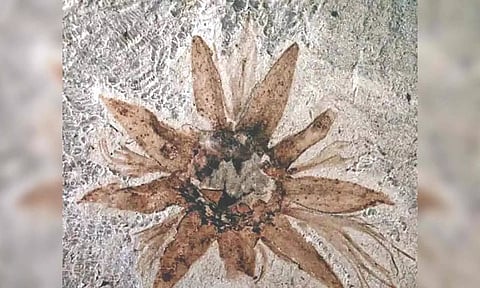

• JACK TAMISIEA
NEW YORK: When a mountain-size slab of space rock rammed into the Yucatán Peninsula 66 million years ago, the fallout was apocalyptic. Tsunamis washed away coastlines, raging fires engulfed forests and dust and debris blotted out the sun for months. Roughly three-fourths of the planet’s species, most notably non-avian dinosaurs, were wiped out.
But one group appears to have weathered the maelstrom. In a paper published Wednesday in the journal Biology Letters, researchers present evidence that flowering plants survived the Cretaceous-Paleogene, or K-Pg, mass extinction relatively unscathed compared with other living things on Earth at the time. The catastrophe may have even helped flowering plants blossom into the dominant green things they are today.
“It’s just bizarre to think that flowering plants survived K-Pg when dinosaurs didn’t,” said Jamie Thompson, an evolutionary biologist at the University of Bath and one of the authors of the study.
Flowering plants are known to scientists as angiosperms. They originated in the early Cretaceous, and were often overshadowed by older groups like conifers and ferns. But they rapidly diversified as mass extinction loomed.
To determine how flowering plants fared during the K-Pg extinction event, Dr. Thompson teamed up with Santiago Ramirez-Barahona, an evolutionary geneticist at the National Autonomous University of Mexico. The pair were initially hindered by a lack of fossil flowers, which are scarce compared with fossilized bones. Some of the largest angiosperm lineages today, like orchids, barely show up in the fossil record.
To uncover the evolutionary insights missing from the fossil record, the researchers analyzed two evolutionary trees containing more than 100,000 species of living angiosperms. These sprawling data sets, known as phylogenies, were calibrated using molecular clues that allow scientists to group related species together and determine when certain lineages diverged. Together, the phylogenies lay out an evolutionary timeline of when the ancestors of modern angiosperm lineages emerged and when they died out.
The researchers discovered something surprising. While many angiosperm species died out with the dinosaurs, pterosaurs and marine reptiles — especially those living near the asteroid impact crater — the larger lineages of flowering plants survived the extinction event and exhibited a relatively constant rate of extinction through time.
“That is actually in perfect step with the plant fossil record,” said Paige Wilson Deibel, a paleobotanist at the Burke Museum in Seattle who studies fossils from the K-Pg boundary in northeastern Montana and was not involved in the new study. “There is really high species-level extinction but the major lineages all seem to have survived.”
This contrasts starkly with the evolutionary tree of dinosaurs. “Non-avian dinosaurs lost so many species, they lost entire lineages, which we don’t see in angiosperms,” Dr. Thompson said. While more work is needed to determine how angiosperms survived one of the deadliest extinctions in Earth’s history, the researchers posit that their adaptability played a role.